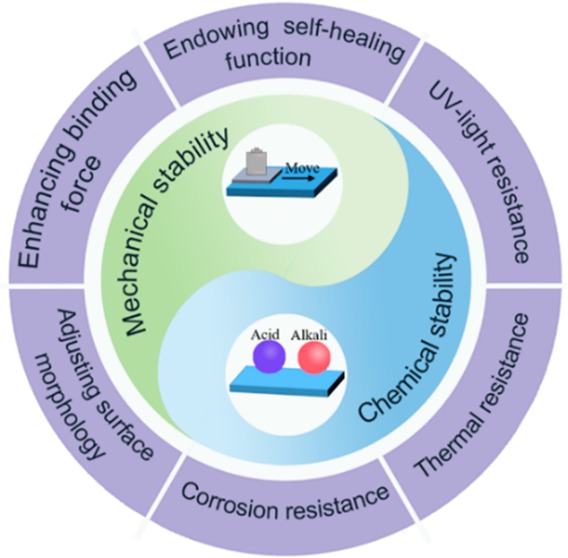- Record: found
- Abstract: found
- Article: not found
Constructing Mechanochemical Durable and Self-Healing Superhydrophobic Surfaces

Read this article at
Abstract

Bioinspired superhydrophobic surfaces have attracted great interest due to their special functions and wide applications. However, it is still a big challenge to construct a durable superhydrophobic coating for large-scale applications due to its easy destruction by the mechanochemical attack. In this mini-review, we present the state-of-the-art developments in the rational design of mechanochemical durable and self-healing superhydrophobic surfaces. First, the mechanically durable superhydrophobic surfaces are constructed to endure mechanical damage by adjusting the surface morphology and increasing the binding force between the substrates and the modified materials. Second, chemical damages also have been taken into consideration to develop chemically robust superhydrophobic surfaces, such as chemical etching, ultraviolet (UV)-light irradiation, and bioerosion, etc. Third, endowing superhydrophobic coatings with self-healing function can effectively improve the durability and prolong the lifespan of the coatings by releasing low-surface-energy agents or regenerating topographic structures. Finally, the challenges and future perspectives in developing super durable bioinspired superhydrophobic surfaces by structure design and chemistry control are discussed. The innovative points provided in this mini-review will provide deep fundamental insight for prolonging the lifetime of the superhydrophobic surfaces and enable their practical applications in the near future.
Related collections
Most cited references29
- Record: found
- Abstract: not found
- Article: not found
All-organic superhydrophobic coatings with mechanochemical robustness and liquid impalement resistance
- Record: found
- Abstract: found
- Article: not found
Robust superhydrophobic TiO2@fabrics for UV shielding, self-cleaning and oil–water separation
- Record: found
- Abstract: found
- Article: not found
